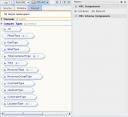This post is a quick reply to the post RSS Is Dying, and You Should Be Very Worried.
I really like rss reader. I have a lot of subscriptions to blogs. But I don’t think that RSS (Really Simple Syndication) has a future, simply because there will be at least one service similar to twitter. People simply like it more: “to follow *people*” and not websites!
Twitter is very powerful. You can create your own RSS-like reader from twitter like I did with jetwick. I mean, what do you want with an RSS reader? You want news, right? Personalized news? With RSS you’ll get news from blogs. With twitter you get personalized news from people as I said before or if you are interested in some topics you can get personalized news via search terms too! That’s very powerful: to get news about topics. That’s what you want, I guess!?
Now there are some good statements in the post where I wanted to add my comment now.
- “IF RSS DIES, WE LOSE THE ABILITY TO READ IN PRIVATE”
First: why would you use chrome if you want to read in private??? 🙂
Second: Yes, privacy is a problem with twitter and facebook. But there will be tools like jetwick where you can “silently” follow people if you want. So this is not an issue for me. Of course, you’ll need to host your own version of jetwick to really have no privacy issues 😉 - “The ability for a website operator to be in control of what he advertise to his users … “
I don’t understand this. A website operator will always have options to advertise … and with RSS reader it is even more likely that the reader skip advertisments. Or what did you mean? - “If every website on the web has to have a Facebook account in order to exist in practical terms, the web is dead—competition is dead“
I don’t think that that will be the case. Browsers will add the ability to post to popular services soon. Similar to the RSS icon in the late 20XX 😉 - “The ability for us to aggregate, mash-up and interpret news without having to go through a closed API that may change on a whim, or disagree with our particular usage”
“A developer should not have to be fluent in Twitter, Facebook and a million different private APIs just to aggregate content from different websites you read”
Valid arguments. But you are more likely to get the latest news via twitter rather than with your static set of blogs. In the end there will be something like a big realtime rss like API without the problems you describe 😉 But yes, this is a big argument. To be tied to an external service is bad.
It is also very powerful that with twitter-like web services
- even people without a blog can share valueable informations (e.g. links)
- a lot of people are already there. As a user RSS is very complicated. You have to search for blogs you are interested in. And because of the massive user-base of twitter you don’t need to mashupthings IMHO.
BTW: why do you use the RSS reader of the browser? I’m using lifera …
BTW2: you can follow me at twitter – and see not only what I’m posting here 😉


